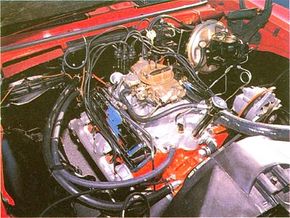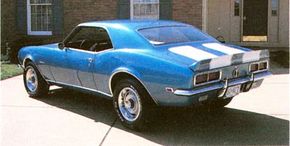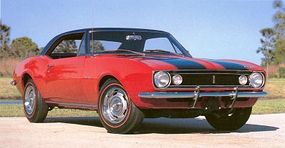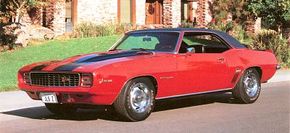The first Z-28 was to Chevrolet's Camaro what the Boss 302 was to Ford's Mustang: a factory-engineered race-ready "ponycar" available at your corner showroom. But where Camaro trailed Mustang to market by two years, the Z-28 appeared two years before the Boss.
Advertisement
Announced in early 1967, some six months after the Camaro itself, the Z-28 was conceived by Chevrolet engineer and product-promotion specialist Vincent W. Piggins. The impetus, as Piggins later explained, was "to develop a performance image for the Camaro that would be superior to Mustang's. Along comes [Sports Car Club of America] in creating the Trans-Am sedan racing class for professional drivers in 1966 ... I suggested a vehicle that would fit this class and, I believe ... it gave them the heart to push ahead.... "
Initially, the Trans-Am involved Group II production cars with wheelbases of 116 inches or less and engines of no more than 305 cubic inches. Certification required at least 1,000 be built per model year. Chevy met this by entering the standard V-8 Camaro as a Group I sports car (over 305 cid) and the Z-28 option under Group II.
Rule-bending aside, the Z-28 was a racer's delight: heavy-duty suspension, power front-disc brakes, metallic-lined rear-drum brakes, 15 x 6 Corvette wheels mounting 7.75 x 15 tires, special hood with functional air intakes, close- or wide-ratio four-speed gearbox, and a new 302 V-8. The last came from slotting the crankshaft from the older 283 engine into the then-current 327 block, yielding 302.4 cid -- just under the limit. Outputs were conservatively stated as 290 horsepower and as many pounds/feet of torque, but actual bhp was nearer 400, thanks to a huge four-barrel Holley carb, oversize intake manifold, big ports and valves, wild 346-degree-duration cam, and cast-iron headers.
Chevrolet called the Z-28 "the closest thing to a 'Vette, yet," and not without reason. Car and Driver clocked one at a blazing 6.7 seconds 0-60 mph, versus 7.8 seconds for the typical four-speed SS350 and slightly under 11 seconds for an automatic 210-bhp 327. Handling was racer-sharp; braking as good as it could be with contemporary technology.
Keep reading to learn about the styling and sales of the 1967-1969 Chevrolet Camaro Z-28.
For more information on cars, check out:
- Classic Cars
- Muscle Cars
- Sports Cars
- Consumer Guide New Car Search
- Consumer Guide Used Car Search
Advertisement



